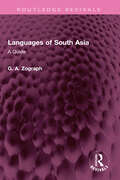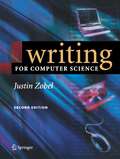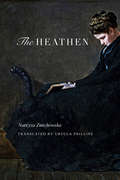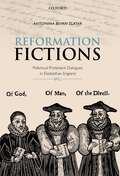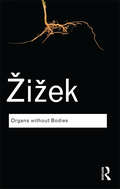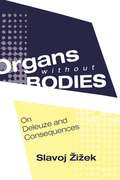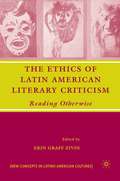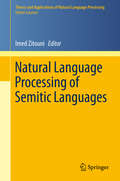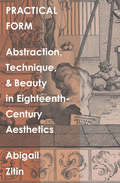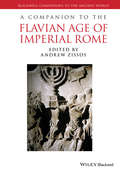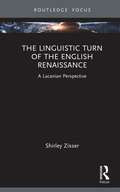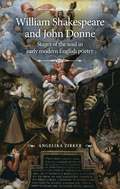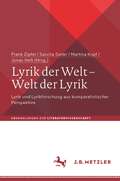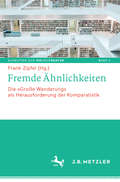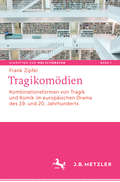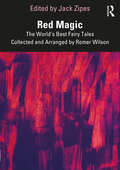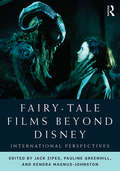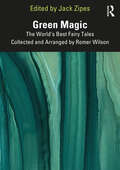- Table View
- List View
Languages of South Asia: A Guide (Routledge Revivals)
by G. A. ZographFirst published in 1982, Languages of South Asia covers all important languages and language groups of the so-called Indian subcontinent (India, Bangladesh, Pakistan, Sri Lanka, Nepal and Bhutan). It concentrates on the more southern languages, that is the Indo-Aryan, Dravidian and Munda groups; a brief survey of Tibeto-Burman languages is also included. As well as giving a description of the current status and character of each language, Dr. Zograph goes into a detailed structural analysis of its phonology, morphology and syntax. The problems of the historical background of the modern languages, and their classification, are also discussed. The book is supplemented by two language maps, tables showing the main alphabets, a bibliography of reliable works on the subject and an index of 350 language names used in the text. This book will be of interest to students of language, linguistics and South Asian studies.
Languages of South Asia: A Guide (Routledge Revivals)
by G. A. ZographFirst published in 1982, Languages of South Asia covers all important languages and language groups of the so-called Indian subcontinent (India, Bangladesh, Pakistan, Sri Lanka, Nepal and Bhutan). It concentrates on the more southern languages, that is the Indo-Aryan, Dravidian and Munda groups; a brief survey of Tibeto-Burman languages is also included. As well as giving a description of the current status and character of each language, Dr. Zograph goes into a detailed structural analysis of its phonology, morphology and syntax. The problems of the historical background of the modern languages, and their classification, are also discussed. The book is supplemented by two language maps, tables showing the main alphabets, a bibliography of reliable works on the subject and an index of 350 language names used in the text. This book will be of interest to students of language, linguistics and South Asian studies.
Writing for Computer Science
by Justin ZobelA complete update to a classic, respected resource Invaluable reference, supplying a comprehensive overview on how to undertake and present research
The Heathen: A Novel
by Narcyza ZmichowskaNarcyza Zmichowska (1819–76) was the most accomplished female writer to come out of Poland in the mid-nineteenth century. In terms of influence and popularity, she was the George Eliot of East European letters, but her fiction was written less in the realist style than in the Romantic one. Her novel The Heathen, rendered here in a crystalline English translation by Ursula Phillips, is the tale of a doomed love affair between Benjamin, a young man from a poor but patriotic rural family, and Aspasia, a femme fatale who is older, beautiful, worldlier, and more sexually liberated.As the story unfolds, Benjamin falls in love with Aspasia, accompanies her to Warsaw, and under her influence achieves incredible intellectual and professional heights—until she tires of him and takes another lover. Jealous, Benjamin murders Aspasia's new paramour and flees to his mother in the countryside—where he realizes the full extent of what he has lost and betrayed. Hence the fundamental tension in this work, represented by the two women who compete for Benjamin's affection: the mother, who represents self-abnegation and redemption from sin, and Aspasia, who represents self-indulgence and sin itself.In the end, The Heathen embodies a profound meditation on the limits of these typecasts: the novel not only explores the restrictions they placed on women during the nineteenth century, but on human happiness, and Poland's then tenuous impulse toward modernity.
Reformation Fictions: Polemical Protestant Dialogues In Elizabethan England
by Antoinina Bevan ZlatarReformation Fictions rehabilitates some twenty polemical dialogues published in Elizabethan England, for the first time giving them a literary, historicist and, to a lesser extent, theological reading. By juxtaposing these Elizabethan publications with key Lutheran and Calvinist dialogues, theological tracts, catechisms, sermons, and dramatic interludes, Antoinina Bevan Zlatar explores how individual dialogists exploit the fictionality of their chosen genre. Writers like John Véron, Anthony Gilby, George Gifford, John Nicholls, Job Throckmorton, and Arthur Dent, to name the most prolific, not only understood the dialogue's didactic advantages over other genres, they also valued it as a strategic defence against the censor. They were convinced, as Erasmus had been before them, that a cast of lively characters presented antithetically, often with a liberal dose of Lucianic humour, worked wonders with carnal readers. Here was an exemplary way to make doctrine entertaining and memorable, here was the honey to make the medicine go down. They knew too that these dialogues, particularly their use of manifestly imaginary interlocutors and a plot of conversion, licensed the delivery of singularly radical messages. What comes to light is a body of literature, often scurrilous, always serious, that gives us access to early modern concepts of fiction, rhetoric, and satire. It showcases the imagery of Protestant polemic against Catholicism, and puritan invective against the established Elizabethan Church, all the while triggering the frisson that comes from the illusion of eavesdropping on early modern conversations.
Organs without Bodies: On Deleuze and Consequences
by Slavoj ZizekWith a new introduction by the author In this deliciously polemical work, a giant of cultural theory immerses himself in the ideas of a giant of French thought. In his inimical style, Zizek links Deleuze's work with both Oedipus and Hegel, figures from whom the French philosopher distanced himself. Zizek turns some Deleuzian concepts around in order to explore the 'organs without bodies' in such films as Fight Club and the works of Hitchcock. Finally, he attacks what he sees as the 'radical chic' Deleuzians, arguing that such projects turn Deleuze into an ideologist of today's 'digital capitalism'. With his brilliant energy and fearless argumentation, Zizek sets out to restore a truer, more radical Deleuze than the one we thought we knew.
Organs without Bodies: On Deleuze and Consequences
by Slavoj ZizekWith a new introduction by the author In this deliciously polemical work, a giant of cultural theory immerses himself in the ideas of a giant of French thought. In his inimical style, Zizek links Deleuze's work with both Oedipus and Hegel, figures from whom the French philosopher distanced himself. Zizek turns some Deleuzian concepts around in order to explore the 'organs without bodies' in such films as Fight Club and the works of Hitchcock. Finally, he attacks what he sees as the 'radical chic' Deleuzians, arguing that such projects turn Deleuze into an ideologist of today's 'digital capitalism'. With his brilliant energy and fearless argumentation, Zizek sets out to restore a truer, more radical Deleuze than the one we thought we knew.
Organs without Bodies: Deleuze and Consequences
by Slavoj ZizekFirst published in 2004. Routledge is an imprint of Taylor & Francis, an informa company.
Organs without Bodies: Deleuze and Consequences
by Slavoj ZizekFirst published in 2004. Routledge is an imprint of Taylor & Francis, an informa company.
The Ethics of Latin American Literary Criticism: Reading Otherwise (New Directions in Latino American Cultures)
by E. ZivinThis volume looks at the shifting role of aesthetics in Latin American literature and literary studies, focusing on the concept of 'ethical responsibility' within these practices. The contributing authors examine the act of reading in its new globalized context of postcolonial theory and gender and performance studies.
Natural Language Processing of Semitic Languages (Theory and Applications of Natural Language Processing)
by Imed ZitouniResearch in Natural Language Processing (NLP) has rapidly advanced in recent years, resulting in exciting algorithms for sophisticated processing of text and speech in various languages. Much of this work focuses on English; in this book we address another group of interesting and challenging languages for NLP research: the Semitic languages. The Semitic group of languages includes Arabic (206 million native speakers), Amharic (27 million), Hebrew (7 million), Tigrinya (6.7 million), Syriac (1 million) and Maltese (419 thousand). Semitic languages exhibit unique morphological processes, challenging syntactic constructions and various other phenomena that are less prevalent in other natural languages. These challenges call for unique solutions, many of which are described in this book.The 13 chapters presented in this book bring together leading scientists from several universities and research institutes worldwide. While this book devotes some attention to cutting-edge algorithms and techniques, its primary purpose is a thorough explication of best practices in the field. Furthermore, every chapter describes how the techniques discussed apply to Semitic languages. The book covers both statistical approaches to NLP, which are dominant across various applications nowadays and the more traditional, rule-based approaches, that were proven useful for several other application domains. We hope that this book will provide a "one-stop-shop'' for all the requisite background and practical advice when building NLP applications for Semitic languages.
Practical Form: Abstraction, Technique, and Beauty in Eighteenth-Century Aesthetics (The Lewis Walpole Series in Eighteenth-Century Culture and History)
by Abigail ZitinA groundbreaking study of the development of form in eighteenth-century aesthetics In this original work, Abigail Zitin proposes a new history of the development of form as a concept in and for aesthetics. Her account substitutes women and artisans for the proverbial man of taste, asserting them as central figures in the rise of aesthetics as a field of philosophical inquiry in eighteenth-century Europe. She shows how the idea of formal abstraction so central to conceptions of beauty in this period emerges from the way practitioners think about craft and skill across the domestic, industrial, and so-called high arts. Zitin elegantly maps the complex connections among aesthetics, form, and formalism, drawing out the understated presence of practice in the writings of major eighteenth-century thinkers including Locke, Addison, Burke, and Kant. This new take on an old story ultimately challenges readers to reconsider form and why it matters.
A Companion to the Flavian Age of Imperial Rome (Blackwell Companions to the Ancient World)
by Andrew ZissosA Companion to the Flavian Age of Imperial Rome provides a systematic and comprehensive examination of the political, economic, social, and cultural nuances of the Flavian Age (69–96 CE). Includes contributions from over two dozen Classical Studies scholars organized into six thematic sections Illustrates how economic, social, and cultural forces interacted to create a variety of social worlds within a composite Roman empire Concludes with a series of appendices that provide detailed chronological and demographic information and an extensive glossary of terms Examines the Flavian Age more broadly and inclusively than ever before incorporating coverage of often neglected groups, such as women and non-Romans within the Empire
A Companion to the Flavian Age of Imperial Rome (Blackwell Companions to the Ancient World)
by Andrew ZissosA Companion to the Flavian Age of Imperial Rome provides a systematic and comprehensive examination of the political, economic, social, and cultural nuances of the Flavian Age (69–96 CE). Includes contributions from over two dozen Classical Studies scholars organized into six thematic sections Illustrates how economic, social, and cultural forces interacted to create a variety of social worlds within a composite Roman empire Concludes with a series of appendices that provide detailed chronological and demographic information and an extensive glossary of terms Examines the Flavian Age more broadly and inclusively than ever before incorporating coverage of often neglected groups, such as women and non-Romans within the Empire
The Linguistic Turn of the English Renaissance: A Lacanian Perspective (Routledge Focus on Mental Health)
by Shirley ZisserThe Linguistic Turn of the English Renaissance: A Lacanian Perspective examines a selection of cultural phenomena of the English Renaissance, all of which include a focus on language, from a Lacanian perspective. The book examines four inter-related cultural symptoms of the English Renaissance: the paucity of painting, the interest in rhetoric, the emergence of a literary style focusing on form and a fascination with the myth of Orpheus. The book argues that the English Renaissance, an apex of rhetorical theory, can offer psychoanalysis further knowledge concerning the intrication of language and flesh, especially where feminine jouissance is at stake. These language-centred phenomena emerge against the backdrop of a peculiar configuration of the visual field, which in contrast to other cultures of the European Renaissance is largely barren of painting other than portraiture. The book will be of interest to psychoanalysts, scholars of Renaissance culture and those interested in the psychoanalytic study of culture.
The Linguistic Turn of the English Renaissance: A Lacanian Perspective (Routledge Focus on Mental Health)
by Shirley ZisserThe Linguistic Turn of the English Renaissance: A Lacanian Perspective examines a selection of cultural phenomena of the English Renaissance, all of which include a focus on language, from a Lacanian perspective. The book examines four inter-related cultural symptoms of the English Renaissance: the paucity of painting, the interest in rhetoric, the emergence of a literary style focusing on form and a fascination with the myth of Orpheus. The book argues that the English Renaissance, an apex of rhetorical theory, can offer psychoanalysis further knowledge concerning the intrication of language and flesh, especially where feminine jouissance is at stake. These language-centred phenomena emerge against the backdrop of a peculiar configuration of the visual field, which in contrast to other cultures of the European Renaissance is largely barren of painting other than portraiture. The book will be of interest to psychoanalysts, scholars of Renaissance culture and those interested in the psychoanalytic study of culture.
William Shakespeare and John Donne: Stages of the soul in early modern English poetry (The Manchester Spenser)
by Angelika ZirkerThis study analyses concepts and representations of the soul in the poetry of William Shakespeare and John Donne. It shows how the soul becomes a linking element between the genres of poetry and drama, and how poetry becomes dramatic whenever the soul is at its focus. This double movement can be observed in Shakespeare’s The Rape of Lucrece and Donne’s Holy Sonnets: in these texts, the connection between interiority and performance, psychology and religious self-care can be found, which is central to the understanding of early modern drama and its characteristic development of the soliloquy. The study thus offers a new reading of the poems by Shakespeare and Donne by analysing them, in different ways, as staged dialogues within the soul. It contributes to research on the soliloquy as much as on concepts of inwardness during the early modern period. The book is aimed at readers studying early modern literature and culture.
William Shakespeare and John Donne: Stages of the soul in early modern English poetry (The Manchester Spenser)
by Angelika ZirkerThis study analyses concepts and representations of the soul in the poetry of William Shakespeare and John Donne. It shows how the soul becomes a linking element between the genres of poetry and drama, and how poetry becomes dramatic whenever the soul is at its focus. This double movement can be observed in Shakespeare’s The Rape of Lucrece and Donne’s Holy Sonnets: in these texts, the connection between interiority and performance, psychology and religious self-care can be found, which is central to the understanding of early modern drama and its characteristic development of the soliloquy. The study thus offers a new reading of the poems by Shakespeare and Donne by analysing them, in different ways, as staged dialogues within the soul. It contributes to research on the soliloquy as much as on concepts of inwardness during the early modern period. The book is aimed at readers studying early modern literature and culture.
Lyrik der Welt – Welt der Lyrik: Lyrik und Lyrikforschung aus komparatistischer Perspektive (Abhandlungen zur Literaturwissenschaft)
by Frank Zipfel Sascha Seiler Martina Kopf Jonas HeßLyrik und Lyriktheorie wurden in der Komparatistik oft vernachlässigt. Aufgrund der besonderen Sprachgebundenheit von Lyrik ist es zwar nicht selbstverständlich, sie aus einer transnationalen, sprachübergreifenden Perspektive zu untersuchen, allerdings bleiben dann wichtige Aspekte der internationalen zeitgenössischen Lyrikproduktion und der Lyriktradition unerkannt und unerforscht. Dieser Sammelband liefert einen Beitrag zur Schließung dieser Lücke, indem er das komplexe Verhältnis zwischen „Lyrik“ und „Welt“ aus komparatistischer Perspektive untersucht und reflektiert. In der Nachfolge von Konzepten wie Goethes Weltpoesie, Ezra Pounds world poetry oder Enzensbergers poetischer Weltsprache, wird die Internationalität der Lyrik in ihrer Verbindung mit verschiedenen ‚Welten‘ beleuchtet: ihr Bezug zur Lebenswelt, ihr Stellung in der Medienwelt, ihre Erforschung in der Wissenschaftswelt.
Fremde Ähnlichkeiten: Die "Große Wanderung" als Herausforderung der Komparatistik (Schriften zur Weltliteratur/Studies on World Literature #4)
by Frank ZipfelAusgehend von der These, dass Literatur im 21. Jahrhundert in vielfacher Weise durch das Phänomen der Wanderung geprägt ist (von der Thematisierung von Migration bis zur beschleunigten ‚Wanderung‘ von Texten über Sprach- und Nationalgrenzen hinweg) stellt der aus einer internationalen Tagung an der Universität Mainz hervorgegangene Band die Frage, wie die Komparatistik auf die zügig sich verändernde literarische Welt reagieren soll. Das aus der Übersetzungstheorie Schleiermachers entlehnte, jedoch neu akzentuierte Konzept der „fremden Ähnlichkeiten“ bietet vielfältige Möglichkeiten, Antworten auf diese Frage zu finden – sowohl auf der Ebene der literaturtheoretischen Reflexion wie auch durch den konkreten Vergleich spezifischer literarischer Texte.
Tragikomödien: Kombinationsformen von Tragik und Komik im europäischen Drama des 19. und 20. Jahrhunderts (Schriften zur Weltliteratur/Studies on World Literature #1)
by Frank ZipfelDie Tragikomödie, verstanden als Kombination von Tragik und Komik im Drama, ist eine von der zeitgenössischen Literaturwissenschaft relativ wenig beachtete Gattung. Dabei bietet sie ein heuristisches Modell, das oft übersehene Zusammenhänge in der europäischen Dramenproduktion von der Spätaufklärung bis zur Gegenwart erkennbar werden lässt. Diese internationalen Verbindungen werden durch eine systematische und vergleichende Beschreibung unterschiedlicher Kombinationsformen von Komik und Tragik in paradigmatischen Dramen der deutschen, französischen, italienischen und englischen Literatur offen gelegt.
Red Magic: The World’s Best Fairy Tales Collected and Arranged by Romer Wilson
by Jack Zipes Kay NielsenWith a Preface and biographies from Jack Zipes, as well as the original illustrations by Kay Nielsen, this collection of fairy tales originally published by the award-winning Romer Wilson – Green Magic (1928), Silver Magic (1929), and Red Magic (1930) – offers a combination of classic fairy tales, alongside lesser known, global and diverse tales. Red Magic contains such classics as “Aladdin and the Wonderful Lamp” from the Arabian Nights, “A Child’s Dream on a Star” by Dickens, and “The Chimera” by Hawthorne. It also contains previously unpublished tales such as “Princess Silver Silk” and “The Enchanted Deer.” It was Romer Wilson’s intention to combine the familiar with the unknown, and to introduce authors and cultures from a variety of countries. As a researcher, Wilson uncovered a remarkable amount of stories from other countries that remain unknown today. This collection gives voice to unique and intriguing tales that inspire children to have a better understanding of how people and their stories are alike despite major differences. Through his Preface and commentary, Jack Zipes shows how all three books are a means to bring people together in the name of peace and justice. These books will, therefore, be of interest to anyone researching or studying fairy tales, folklore and children’s literature, as well as global or comparative literature and social justice.
Fairy-Tale Films Beyond Disney: International Perspectives
by Jack Zipes Pauline Greenhill Kendra Magnus-JohnstonThe fairy tale has become one of the dominant cultural forms and genres internationally, thanks in large part to its many manifestations on screen. Yet the history and relevance of the fairy-tale film have largely been neglected. In this follow-up to Jack Zipes’s award-winning book The Enchanted Screen (2011), Fairy-Tale Films Beyond Disney offers the first book-length multinational, multidisciplinary exploration of fairy-tale cinema. Bringing together twenty-three of the world’s top fairy-tale scholars to analyze the enormous scope of these films, Zipes and colleagues Pauline Greenhill and Kendra Magnus-Johnston present perspectives on film from every part of the globe, from Hayao Miyazaki’s Spirited Away, to Jan Švankmajer’s Alice, to the transnational adaptations of 1001 Nights and Hans Christian Andersen. Contributors explore filmic traditions in each area not only from their different cultural backgrounds, but from a range of academic fields, including criminal justice studies, education, film studies, folkloristics, gender studies, and literary studies. Fairy-Tale Films Beyond Disney offers readers an opportunity to explore the intersections, disparities, historical and national contexts of its subject, and to further appreciate what has become an undeniably global phenomenon.
Fairy-Tale Films Beyond Disney: International Perspectives
by Jack Zipes Pauline Greenhill Kendra Magnus-JohnstonThe fairy tale has become one of the dominant cultural forms and genres internationally, thanks in large part to its many manifestations on screen. Yet the history and relevance of the fairy-tale film have largely been neglected. In this follow-up to Jack Zipes’s award-winning book The Enchanted Screen (2011), Fairy-Tale Films Beyond Disney offers the first book-length multinational, multidisciplinary exploration of fairy-tale cinema. Bringing together twenty-three of the world’s top fairy-tale scholars to analyze the enormous scope of these films, Zipes and colleagues Pauline Greenhill and Kendra Magnus-Johnston present perspectives on film from every part of the globe, from Hayao Miyazaki’s Spirited Away, to Jan Švankmajer’s Alice, to the transnational adaptations of 1001 Nights and Hans Christian Andersen. Contributors explore filmic traditions in each area not only from their different cultural backgrounds, but from a range of academic fields, including criminal justice studies, education, film studies, folkloristics, gender studies, and literary studies. Fairy-Tale Films Beyond Disney offers readers an opportunity to explore the intersections, disparities, historical and national contexts of its subject, and to further appreciate what has become an undeniably global phenomenon.
Green Magic: The World’s Best Fairy Tales Collected and Arranged by Romer Wilson
by Jack Zipes Violet BruntonWith a Preface and biographies from Jack Zipes, as well as the original illustrations by Violet Brunton, this collection of fairy tales originally published by the award-winning Romer Wilson – Green Magic (1928), Silver Magic (1929), and Red Magic (1930) – offers a combination of classic fairy tales, alongside lesser-known, global and diverse tales. Green Magic contains many traditional fairy tales, including “Rapunzel” by Grimm, “Ali Baba” by Diyab and Galland, and “Puss in Boots” by Perrault, as well as previously unknown tales, such as “The Golden Twins” by Iperescu and “The Brotherless Girl” by an anonymous author. It was Romer Wilson’s intention to combine the familiar with the unknown, and introduce authors and cultures from a variety of countries. As a researcher, she uncovered a remarkable amount of stories from other countries that remain unknown today. The collection gives voice to unique and intriguing tales that inspire children to have a better understanding of how people and their stories are alike despite major differences. Through his Preface and commentary, Jack Zipes shows how all three books are a means to bring people together in the name of peace and justice. These books will therefore be of interest to anyone researching or studying fairy tales, folklore, and children’s literature, as well as global or comparative literature and social justice.
